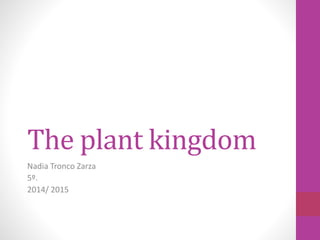The plant kingdom
•Descargar como PPTX, PDF•
0 recomendaciones•1,268 vistas
Denunciar
Compartir
Denunciar
Compartir

Más contenido relacionado
La actualidad más candente
La actualidad más candente (20)
Plant unit: a study on plant classification, germination, pollination, trans...

Plant unit: a study on plant classification, germination, pollination, trans...
Destacado
Destacado (20)
Similar a The plant kingdom
Similar a The plant kingdom (20)
The plant kingdom
- 1. The plant kingdom Nadia Tronco Zarza 5º. 2014/ 2015
- 2. ANALYSE AND ORGANISE LIVING THINGS green multicellular ARE cant move from place to place PLANTS characteristics make their own food interact witch their environment EXAMPLES CACTUS FLOWERS TREE
- 3. CLASSIFICATION OF PLANTS Plants are divided into: flowering plants and non-flowering plants. Flowering plants : angiosperm and gyimnosperms Non – flowering plants: ferns and mosses. Angiosperms: Produce fruits with seeds inside. Examples: Cherry Trees. Gymnosperms: Have small flowers. They don´t produce any fruit and their seeds develop in cones. Ferns: They hace roots and strong Mosses: They produce sores inside capsules.
- 4. Parts of plants • Roots: The roots hold the plant in the ground. Roots absorb water and minerals needed for nutrition from the ground through the roots hairs. • Stem: The stem holds up the pther àrts pf the plant, It also transports materials to and from the leaves. Water and minerals travel through the stem yo the leaves for photosyntesis. The food produced through photosyntesis then travels to the other parts pf the plan. • Leaves: Leaves contain chlorophyll, a green subtance which is necessary for hotosyntesis. Most leaves have two parts: the petiole and the blade. Veins in the blade support the leaf and carry water and minerals. On the underside of the blade, there are tiny holes, called stomata. The gas exchange in leaves takes place through stomata